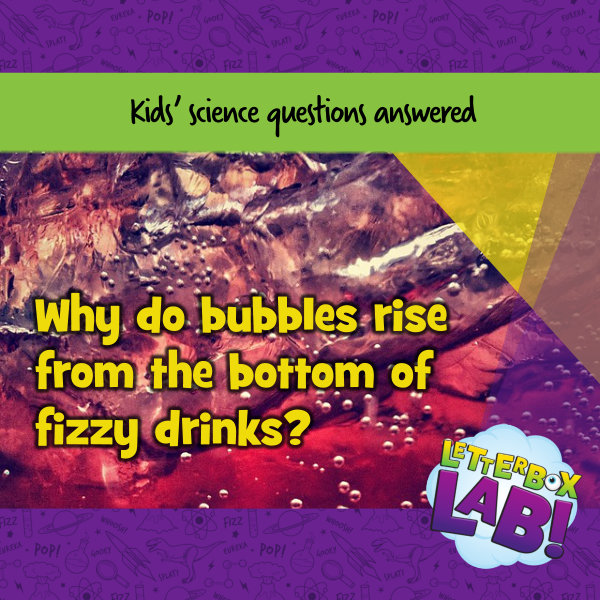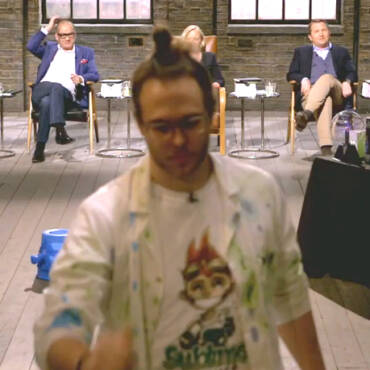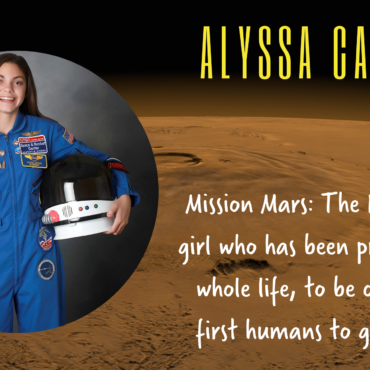Why do bubbles keep rising from the bottom of fizzy drinks and don’t run out?
This one question, asked of us by an 11 year old friend of Letterbox Lab, has a few interesting questions wrapped up in it.
Why do bubbles come out of fizzy drinks?
Carbon dioxide is the gas responsible for the fizz in fizzy drinks. This carbon dioxide stays dissolved in the drink because the bottle contains a lot of pressure and a liquid can hold more gas if it’s under pressure. You feel this pressure being released when you open a fresh bottle of pop.
Then you pour your fizzy drink into a glass. The high pressure that was once holding the carbon dioxide in the liquid is now gone. There is more carbon dioxide in the drink than the drink can hold so the carbon dioxide comes out as bubbles. But, the gas doesn’t all come rushing out at once.
Why do the bubbles come from the bottom?
Instead of instantly bubbling out of the drink the gas bubbles out quite slowly at the bottom and sides of the glass. This is because bubbles are not easy to make. You can think of it like this, the little carbon dioxide molecules want to get out of the drink but they need a few of them to get together and make a bubble before they can escape. They are all randomly jiggling around inside the liquid so it’s not very often that enough of them stick together to make a bubble.
The bottom and sides of the glass have tiny little imperfections on them, microscopic dents and scratches. There is already a tiny bubble of gas trapped in these imperfections. When a carbon dioxide molecule collides with this bubble they merge making a bubble that is too big for the scratch or dent to hold. So the bubble breaks in half, some of it stays behind and some of it floats up to the surface and pops. Because some of it stays behind the same thing can keep happening over and over again. This is why you see a stream of little bubbles coming from certain points on the glass. Some glasses are actually designed to have these little scratches to make more bubbles.
Why don’t the bubbles run out?
The science says that there is only a certain amount of carbon dioxide in the liquid and once it’s gone the bubbles will stop. This will take a long time because the events described above are pretty slow so it might appear that the bubbles don’t run out because you have finished your drink before the carbon dioxide has had time to get out.
But you shouldn’t take our word for it when it’s easy to do some experimenting yourself. Pour yourself a glass of something fizzy and leave it undisturbed. Do the bubbles ever stop? How long does it take? If so, can you think of a way to speed up or slow down the process? You can get an idea of how much carbon dioxide is in the drink if you put the glass on some weighing scales – the weight should go down because even bubbles have weight. Or you could try putting a balloon over the neck of a bottle, will the bubbles inflate the balloon?
Happy experimenting.
Would you like to spend time with your children doing something that’s fun and educational for them and hassle-free for you?
Letterbox Lab is a monthly science kit that arrives through your letterbox containing everything you need to perform incredible experiments with your children.
Your children will love it. It’s colour changing, fizzing reactons, slimes, things that glow in the dark, making helicopters and catapults. All with beautifully illustrated comic-style instructions that they will actually enjoy reading.
You’ll love it because it’s so easy. It just arrives at your house with everything you need to do all the experiments. Unlike other science kits there’s no looking in the back of cupboard for cream of tartar or figuring out where you can buy propanol on a Sunday afternoon. You just open the box and get started with ease.
Find out more about our unique series of science kits here
Take a look at our other Halloween science activities: Glow in the Dark Slime here




Add Comment